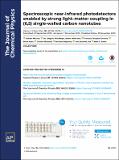Spectroscopic near-infrared photodetectors enabled by strong light-matter coupling in (6,5) single-walled carbon nanotubes
Abstract
Strong light-matter coupling leads to the formation of mixed exciton-polariton states, allowing for a rigorous manipulation of the absorption and emission of excitonic materials. Here, we demonstrate the realization of this promising concept in organic photodetectors. By hybridizing the E11 exciton of semiconducting (6,5) single-walled carbon nanotubes (SWNTs) with near-infrared cavity photons, we create spectrally tunable polariton states within a photodiode. In turn, we are able to red-shift the detection peak which coincides with the lower polariton band. Our photodiodes comprise a metal cavity to mediate strong coupling between light and SWNTs and utilize P3HT and PC70BM as electron donor and acceptor, respectively. The diodes are formed either via mixing of SWNTs, P3HT and PC70BM to create a bulk heterojunction or by sequential processing of layers to form flat heterojunctions. The resulting near-infrared sensors show tunable, efficient exciton harvesting in an application-relevant wavelength range between 1000 nm and 1300 nm, with optical simulations showing a possible extension beyond 1500 nm.
Citation
Mischok , A , Lüttgens , J , Berger , F , Hillebrandt , S G H , Tenopala Carmona , F , Kwon , S , Murawski , C , Siegmund , B , Zaumseil , J & Gather , M C 2020 , ' Spectroscopic near-infrared photodetectors enabled by strong light-matter coupling in (6,5) single-walled carbon nanotubes ' , Journal of Chemical Physics , vol. 153 , no. 20 , 201104 . https://doi.org/10.1063/5.0031293
Publication
Journal of Chemical Physics
Status
Peer reviewed
ISSN
0021-9606Type
Journal article
Description
Special Issue: Polariton Chemistry: Molecules in Cavities and Plasmonic Media. Funding: The authors gratefully acknowledge funding by the Volkswagen Foundation within project No. 93404. A.M. acknowledges further funding through an individual fellowship of the Deutsche Forschungsgemeinschaft (No. 404587082).Collections
Items in the St Andrews Research Repository are protected by copyright, with all rights reserved, unless otherwise indicated.

